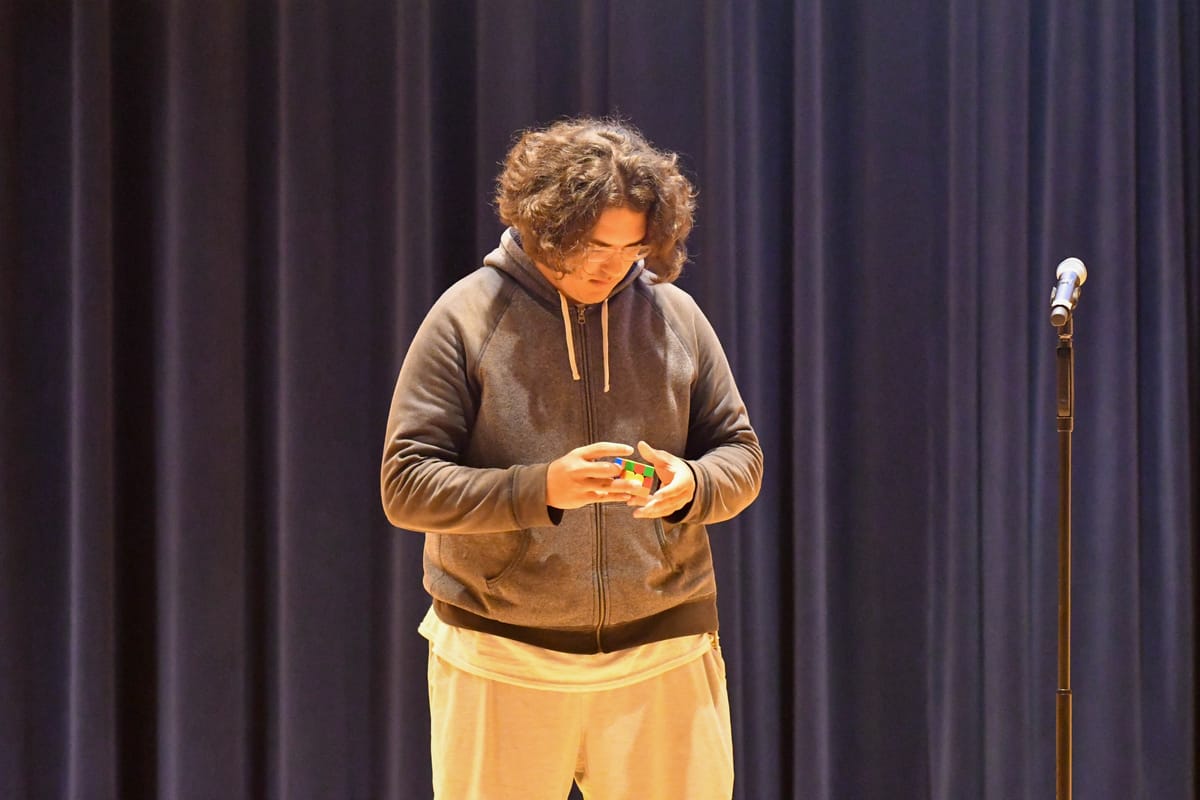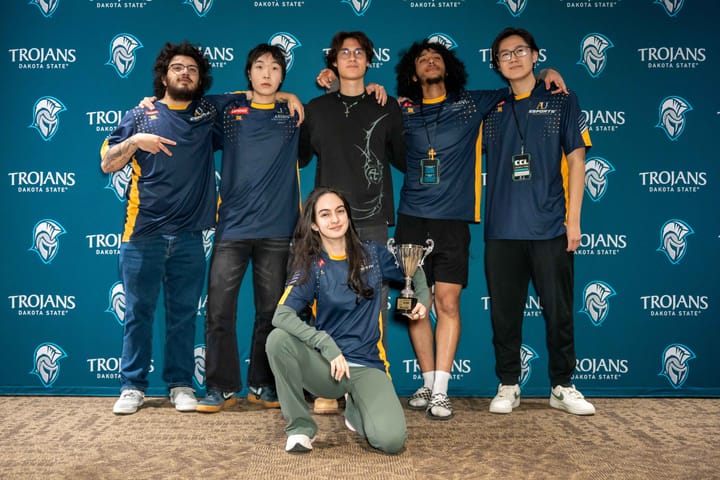Freshman competitive cuber's race against the clock

Hamre Hall is packed, buzzing with excitement. Welcome Week’s New Student Variety is in full swing — students clap and cheer as singers, musicians, dancers and poets take the stage to show off their talents.
After the first few performers, a tall figure steps onstage. He stands about 6 feet tall with dark curly hair pulled back into a ponytail, wearing a worn sweatshirt hanging loosely over athletic shorts. Music begins pumping through the hall’s speaker system and the man lifts a cube into the air. Suddenly, his hands spring to life. The cube clicks rapidly as colors spin and shift at the touch of his fingertips. Each flick of his fingers sends colors twisting and dancing across the cube, rearranging like the scattered tiles of a mosaic suddenly snapping into place. Within seconds, the cube is solved. Then, without delay, he reaches into his pocket, whips out a flute and begins to play.
“It was awesome,” freshman business major Abby Boltjes says. “The crowd was going crazy — it was insane.”
The student on stage was Alex Poitra, a freshman mathematics and computer science major and competitive speedcuber, whose performance that night was as unexpected as it was unforgettable. But for Poitra, cubing isn’t just a fun party trick — it’s a practiced skill, a daily habit and a competitive sport.
While the first official speedcubing event, the World Rubik’s Cube Championship, was held in 1982, the sport began to gain traction after the formation of the World Cubing Association (WCA) in 2004. Governed by the WCA, official competitions now feature everything from one-handed solves to blindfolded attempts. In 2024 alone, more than 2,700 competitions were held across 102 countries, with over 63,000 participants — including nearly 33,000 newcomers.
Poitra currently averages around 13 seconds per 3x3 solve and regularly competes in several of the 17 WCA-sanctioned events. His favorite events include the standard 3x3, 4x4 and one-handed categories. But his journey began not with speed, but with curiosity.
Poitra says his first solve took around three days and was the result of watching numerous Youtube tutorials to figure out each step.
“I initially started cubing in November 2021,” Poitra says. “It was mostly because of the senior who was in my orchestra class. He was very good at solving the 4x4.”
That senior was Carter Bitz, now a WCA delegate and competitive cuber himself.
“[Poitra] picked it up and then just kept getting faster,” Bitz says. “Every time I see him, he has it either in his hand or in his pocket. I know that he’s kind of always trying to get better.”
At first, Poitra used a standard Rubik’s Brand Cube.
“I would use it at school and it was really loud,” he says. “I'm sure my teachers were not happy with me about it.”
Bitz noticed this and decided to offer Poitra an upgrade.
“It wasn’t the best cube — it wasn’t magnetic or anything — but it was definitely a cheap cube that was much better than a Rubik’s Brand,” Bitz says.
In contrast to a standard Rubik’s Cube, speedcubes are designed with smoother turns, corner-cutting, and even magnets that help pieces snap into place. To improve performance, cubers also apply specialized lubricants known in the community as “cube lube” to reduce friction and increase turning speed.
“If you give a top cuber a Rubik’s Brand, they’ll probably go from averaging like five or six seconds to like 15,” Poitra says.
After learning to solve a cube, the next step is to learn algorithms, set patterns of moves created to efficiently reposition pieces of the cube based on its current configuration.
Poitra currently uses the CFOP, one of the most commonly used solving methods. CFOP is an acronym for the four stages of this method — Cross, F2L (First Two Layers), OLL (Orientation of the Last Layer), and PLL (Permutation of the Last Layer) — which uses a set of maneuvers to solve the cube layer by layer. Each stage requires specific algorithms, or patterns of movement, to complete, starting with building a cross with the white faces and ending with a fully solved cube. So far Poitra has memorized around 70 distinct algorithms and continues learning more as he refines his technique.
But cubing isn’t just about memorizing algorithms.
“For competition, I would say one of the biggest skills is your mental fortitude,” Poitra says. “At my last competition, I ended up not doing well in later events purely because I was very mentally exhausted.”
WCA competitions can last all day, with scores of competitors competing in multiple events. Having organized several WCA competitions in Sioux Falls and competed in many himself, Bitz says the atmosphere is centered around community with cubers of all ages encouraging one another, trading tips and celebrating each other’s progress.
“It’s not as much like another sport where your parents sign you up and you need to go and do good or they’re going to be disappointed,” Bitz says. “It’s kind of everyone goes there and, like, yeah, you’re competing, but you're mostly just trying to improve your own times.”
That sense of improvement drives Poitra. Currently, he is focused on mastering a more advanced version of CFOP that would require him to learn around fifteen new algorithms.
As Poitra’s times improve, he hopes to put his skills to the test at more official events. With limited competitions in Sioux Falls, that likely means traveling out of state. He already has his sights set on a competition in Minnesota this summer.
Poitra’s quiet dedication might not always attract attention; yet that night in Hamre Hall, his unconventional and unexpected performance captured an audience. But for those who know him, it made perfect sense.
“That is, like, Alex in a nutshell,” friend and fellow musician Richard Haeder says. “Flute, Rubik’s Cube and random — that’s Alex.”
While many might assume that solving a Rubik’s Cube requires an innate intelligence, Poitra has a different perspective.
“A lot of people associate being able to solve a Rubik’s Cube with your intelligence. I wouldn’t really say it is,” Poitra said. “I wouldn’t consider myself all that, like, smart — it’s just more of a willingness to put in the effort to learn.”



